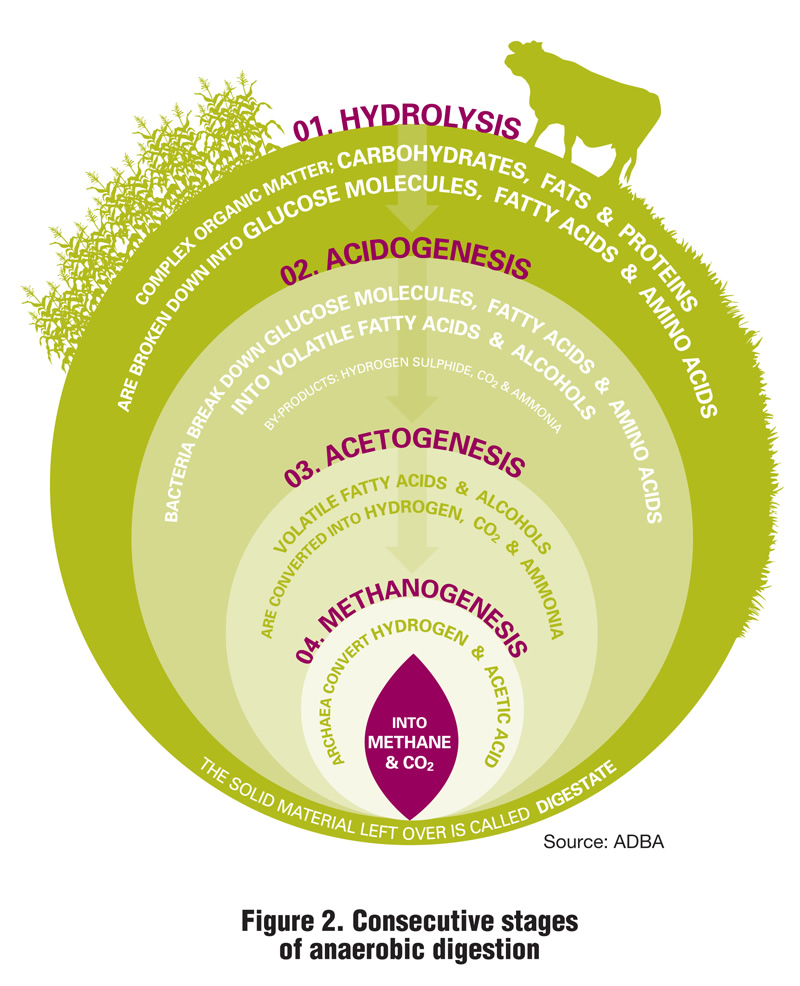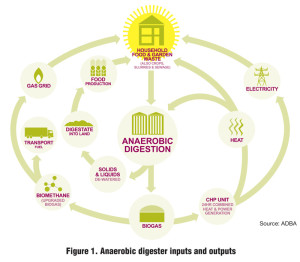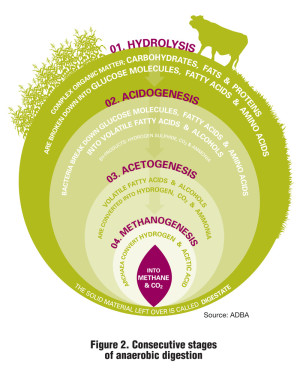From conception through end use, a new UK publication covers key topics for setting up and operating an anaerobic digestion plant.
David Riggle
BioCycle November 2013
While UK-focused, The Practical Guide to AD, a new publication by the Anaerobic Digestion & Biogas Association (ABDA) in the United Kingdom, is relevant for anyone developing a new anaerobic digestion (AD) project. “This hands-on guide was put together by a huge range of contributors and industry experts,” says Charlotte Morton, Chief Executive of ADBA. Many of the Association’s 13 Working Groups — each specializing in a subject area such as feedstocks, biogas to electricity, biomethane to grid, digestate use, and training and safety — were involved in formulating and ensuring the accuracy of the chapters relating to their areas of expertise. Other organizations, such as the Environment Agency and WRAP (the UK’s Waste Resources Action Programme) also were involved.
“We needed to make clear at the outset that AD is not just one technology,” explains Robin Szmidt of Kuettner UK, chair of ADBA’s Dry AD working group and a member of the review team that coordinated production of the book. “There are wet systems, dry systems, batch systems and continuous systems. For a system to work it has to have front-end treatment, waste reception, back-end treatment and digestate handling. There’s also all the environmental protection on site, energy liaison with power companies and other businesses, plus properly managing all the processes and risks involved. To write a guide to AD meant that it would have to be a guide to a framework for how you create a facility, and that’s what has happened here.”
Figure 1 illustrates the inputs and outputs of a facility, providing a simplistic overview. The entire guide successfully communicates scientific and technical detail in a manner that is clear to AD newcomers and valuable to existing practitioners. The descriptions of the consecutive stages of anaerobic digestion — hydrolysis, acidification (to pH of 5) and then methanogenesis at pH >7 — are clear and helpful, as isthe descriptive diagram (Figure 2). The accompanying sidebar about doubling methanogens with proper hydrolysis is typical of the style throughout.
“Nitty gritty” particulars are discussed. For example, after stating that it’s essential for grit (e.g., fine glass, eggshells, sand) to be separated before it gets into the digester so that it doesn’t settle and slowly fill up the tank, the Guide notes: “…Grit is separated by gravity and obeys Stokes Law. Put simply, this means that the smaller a grit particle and the more viscous a fluid, the less likely the grit particle is to settle. In practice, this means that grit may be carried by a slurry without settling until it reaches the digester, whereupon the slurry becomes thinner (less viscous), thus allowing the grit to settle. In order for grit to settle, slurry must be a liquid — grit will not settle out of a thick paste or solid. …. It is worth noting that, despite some manufacturers’ claims to the contrary, mixing systems do not suspend large grit particles. … A typical 30,000 tons/year (tpy) food waste plant can produce as much as 10 tonnes of grit per week and an MSW plant will produce far more.”
The book provides practical guidance on digestate, namely, the sheer quantity that will be produced and for which a use must be found. “…If digestate is being recycled as a liquid, the most crucial design and operational issue is storage. A 30,000 tpy food waste plant will require around 15,000 tpy of liquid storage, as the recycling route will only be available for approximately six months of the year depending on crop rotation and nitrate vulnerable zones (NVZs). Another consideration is how the whole digestate will be recycled. If possible, the best approach is to pump the digestate to the fields where it will be spread. Tankering would require approximately 50 tanker movements for every 1000 m3 of whole digestate being spread.”
Practical information is provided in the chapter on AD Processes, e.g., dewatering requirements. The authors note: “If the centrate (liquid fraction from dewatering) is to undergo further treatment then it is essential that the dewatering stage captures sufficient solids to ensure that the centrate has low total suspended solids. When specifying and commissioning a dewatering stage, the quality of the liquor coming off is as important as the dry solids concentration in the cake. Most aerobic treatment stages following dewatering will only function with an incoming feed of less than 3,000 mg/l total solids (0.3% DS).”
Given that pressurized vessels, explosive atmospheres, confined spaces and toxic and corrosive gases are involved in anaerobic digestion processes, the guide devotes a chapter and an appendix to the subject of health and safety. That consciousness extends to other parts of the text, such as the following passage about design considerations for the gas system: “Described in its simplest form, the gas system is designed to transport the biogas produced by the digester to the CHP /boiler/gas upgrade plant so that it can be converted into useful energy. What is often overlooked is that the gas system is also an integral part of the safe plant design, comprising the pipework, mechanical equipment, gas clean up, flare, instrumentation and storage plant that contains, or is in contact with, biogas. …. The first thing to consider when designing and operating a gas system is that when biogas is produced by the digester it is saturated with water. As the biogas cools, water condenses and will quickly flood any low-lying pipework unless continuously drained. All gas pipework should therefore be installed with sufficient drainage at low points where condensation can be collected and removed safely.”
Who Benefits?
When asked who she thought would most benefit from the Guide, Morton suggested it is a very good resource for people who have just started thinking about AD and are just at the beginning of the project development journey. “It’s also a particularly good resource for the finance community,” she said, “and will help them really understand what these plants are about and what they should be looking at prior to investing. Representatives from throughout the industry took part in putting it together because we all want the industry to be successful.”
In conclusion, Szmidt adds that some people still refer to AD as “new technology” and can be a bit cautious about it. “One of the purposes of this Guide,” he says, “is to demonstrate that it’s cutting edge technology, on the one hand, but that it’s also safe, proven, industrial-scale technology which is there to be used for our collective benefit. For investors, local authorities and others who still have some resistance to AD technologies, this book clearly shows that it is environmentally safe — and good for business.”
David Riggle is International Editor and a past Managing Editor of BioCycle. He has been living and working in Scotland for the past 14 years. The Practical Guide to AD is free to ADBA members as well as for sale on the website: www.adbiogas.co.uk/resources/the-practical-guide-to-ad/.














